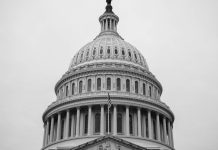Now that Trump’s travel ban has itself been banned (for now), what happens next?
The White House has already indicated that it will fight the decision. In a statement Friday, White House press secretary Sean Spicer said:
“At the earliest possible time, the Department of Justice intends to file an emergency stay of this outrageous order and defend the executive order of the President, which we believe is lawful and appropriate.”
https://www.youtube.com/watch?v=HAv8ZM69otU&t=4m53s
Bob Ferguson, Washington’s Attorney General, was one of the plaintiffs in the case that produced the temporary cessation of the travel ban Friday. Speaking last night, he said he was prepared to take the case all the way to the Supreme Court.
What happens when it gets there is anyone’s guess.
Constitutional scholars and political scientists have expressed serious concerns over the executive order.
Specifically, they argue that the order violates the Equal Protection clause, a 14th Amendment protection that ensures anyone in the U.S. receives treatment in accordance with American law.
It also violates the Establishment Clause, a First Amendment provision that prevents policies favoring one religion over another. Trump’s adviser Rudy Giuliani – a key architect of the travel ban – admitted in an interview that despite the ban’s nominal focus on national origin, it was in fact designed to discriminate against Muslims.
And finally, the ban challenges the due process clause, a Constitutional principle derived from the Fifth and 14th Amendments. Due process violations occur when legal procedures are arbitrary or when defendants are not given the opportunity to defend themselves. Given the confusing and inconsistent application of the travel ban, a due process violation should be easy enough to prove.
On the other hand, the president does have broad powers when it comes to immigration. Rolling back an executive order like the travel ban could be difficult.
And Trump is even more likely to secure a victory if his Supreme Court nominee, Neil Gorsuch, is approved. Gorsuch’s confirmation would tilt the court in a conservative direction, with five conservative justices and four liberal justices.
Trump himself would have little direct involvement with the case. But it would be surprising if he did not publicly pressure Supreme Court justices in the same way he pressured Judge Gonzalo Curiel, the federal judge of Mexican heritage who presided over the Trump University lawsuit. In that case, Trump insisted that because of his anti-immigration stance on Mexico – the very stance that inspired the executive order currently in dispute – Curiel would rule unfairly and should recuse himself from the case.
Curiel did not recuse himself from the case (and Trump’s own lawyers refused to take action to remove Curiel). But Trump could target liberal justice Ruth Bader Ginsburg in a similar manner.
Ginsburg was an outspoken critic of Trump during last year’s presidential campaign, saying:
“I can’t imagine what this place would be – I can’t imagine what the country would be – with Donald Trump as our president.”
Ginsburg later called Trump a “faker” and criticized what she perceived as gentle treatment from the press.
But Steven Lubet of Northwestern Pritzker School of Law says that it’s just as unrealistic to expect Ginsburg to recuse herself over the executive order as it was to expect Curiel to recuse himself.
“Policies don’t involve the personal fortunes of the president, so challenges on executive power or the legality of programs would not trigger disqualification.”
Whatever happens, the fight over Trump’s executive order is an important first test of whether his prejudiced policies have any legal merit.
Featured image via YouTube video.





